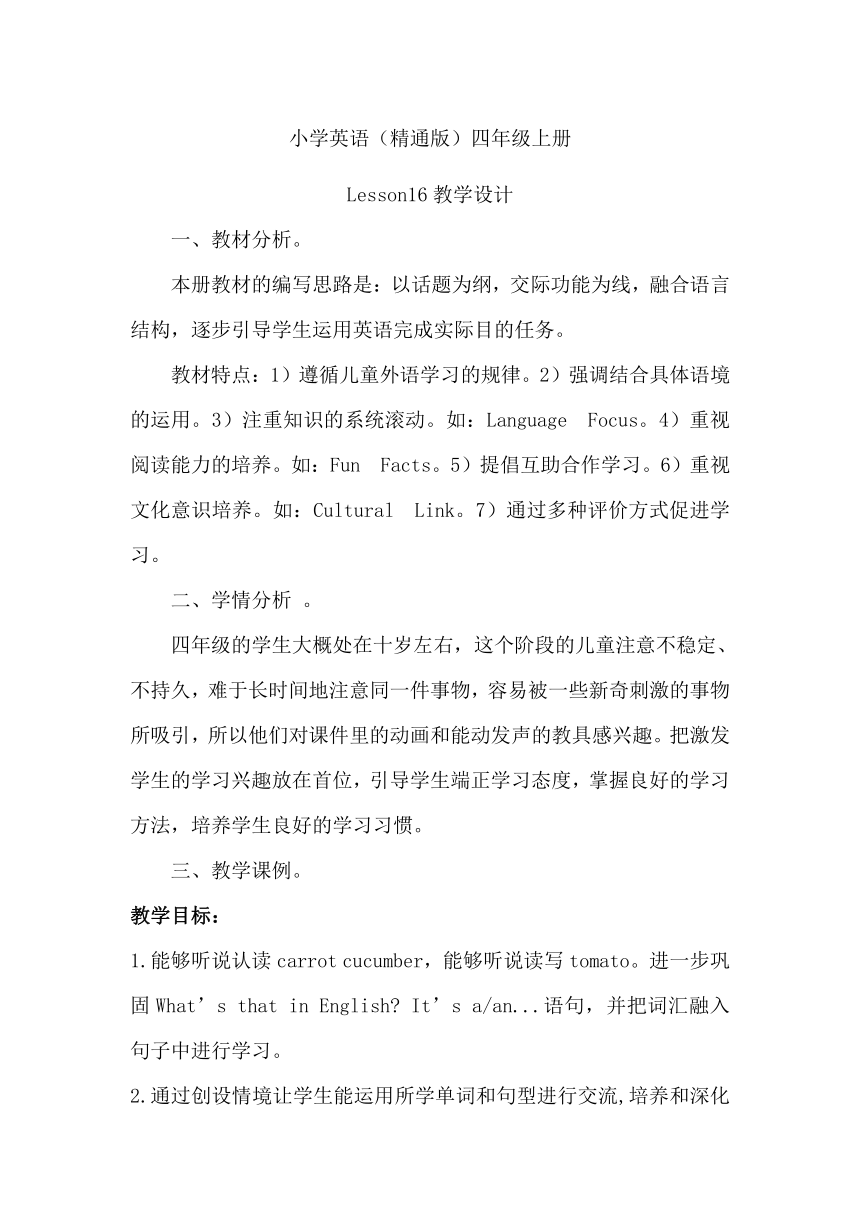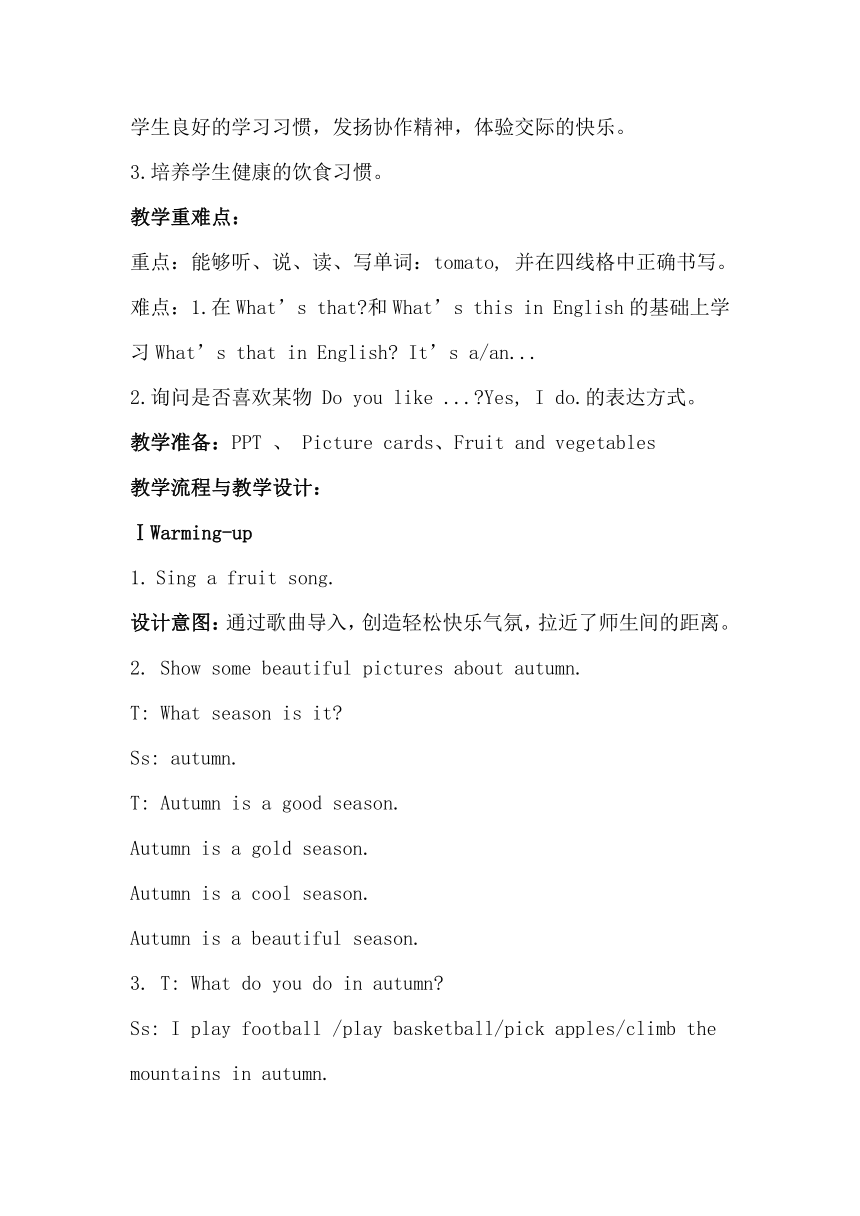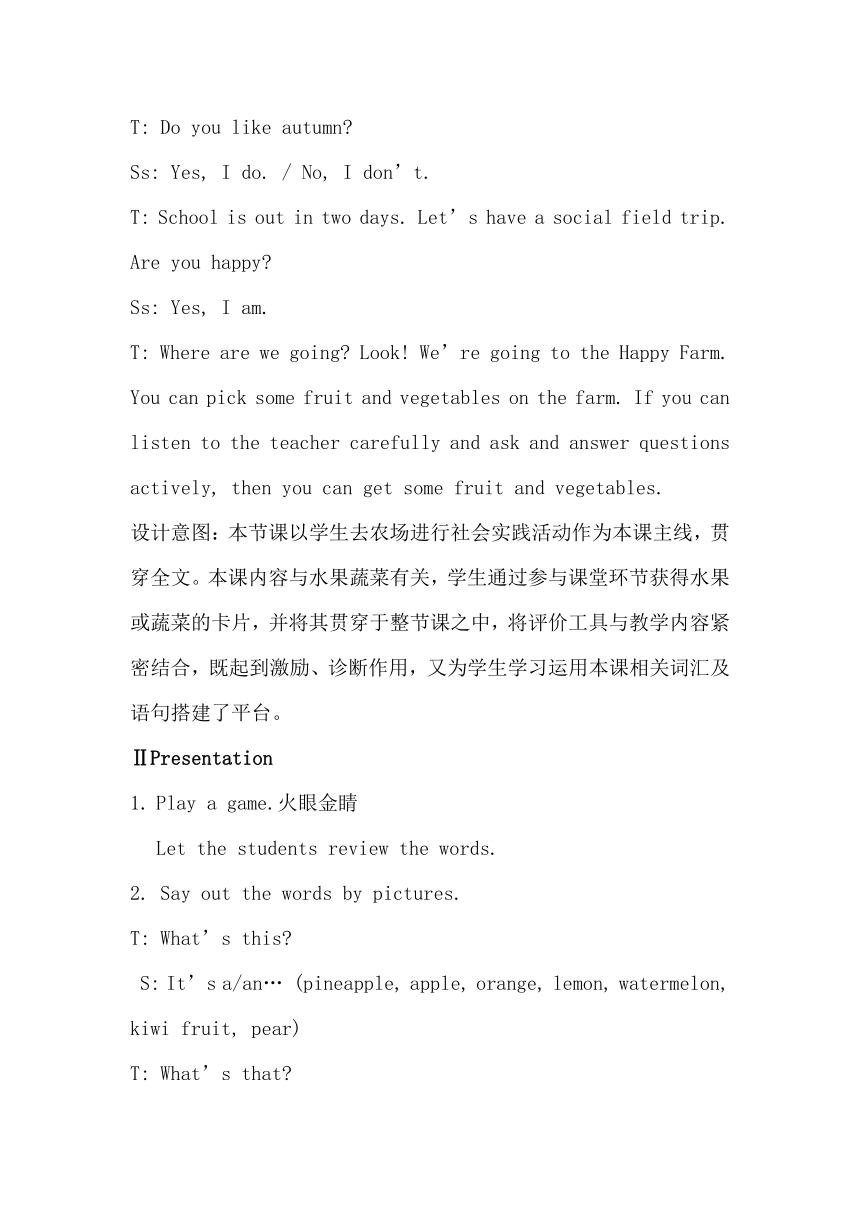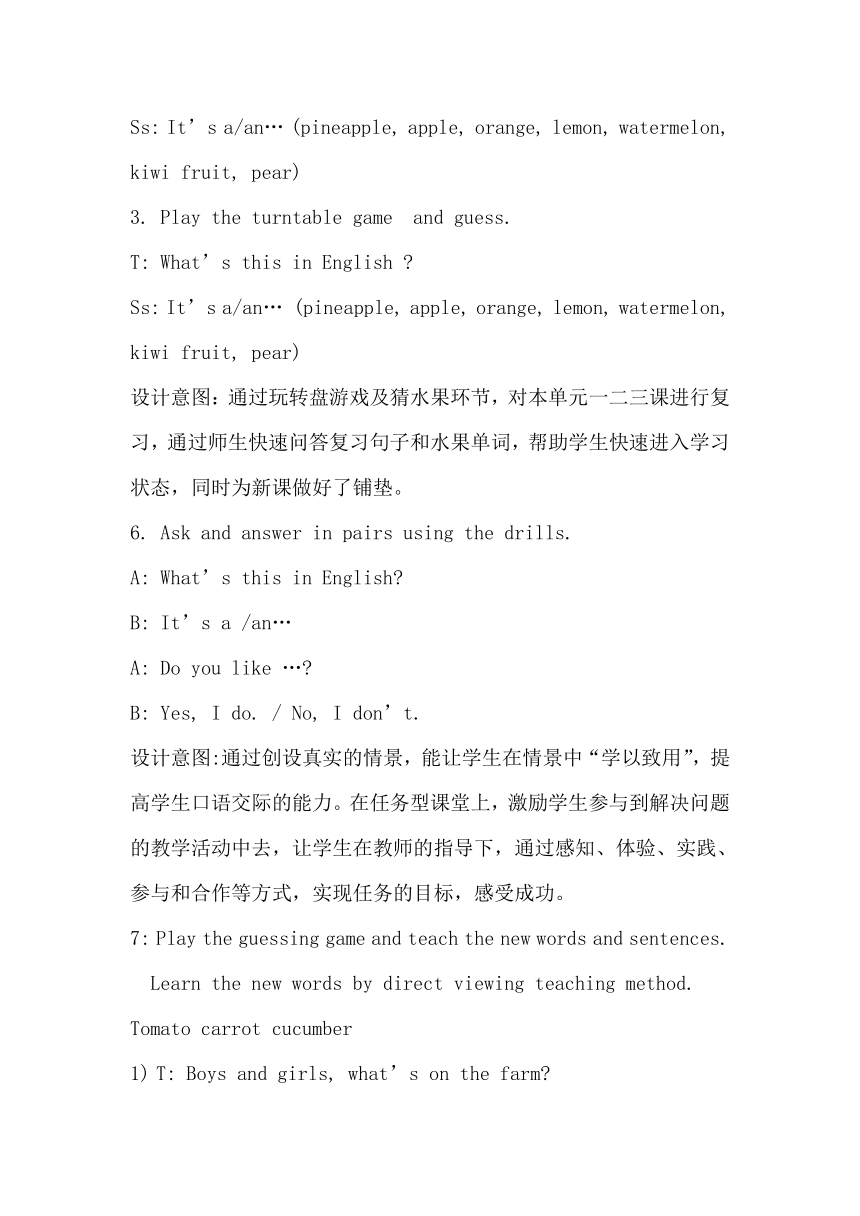Unit3 It's a pineapple Lesson16 说课教案(含教学反思)
文档属性
| 名称 | Unit3 It's a pineapple Lesson16 说课教案(含教学反思) |  | |
| 格式 | doc | ||
| 文件大小 | 56.5KB | ||
| 资源类型 | 教案 | ||
| 版本资源 | 人教精通版(三年级起点) | ||
| 科目 | 英语 | ||
| 更新时间 | 2020-08-29 22:51:55 | ||
图片预览




文档简介
小学英语(精通版)四年级上册
Lesson16教学设计
一、教材分析。
本册教材的编写思路是:以话题为纲,交际功能为线,融合语言结构,逐步引导学生运用英语完成实际目的任务。
教材特点:1)遵循儿童外语学习的规律。2)强调结合具体语境的运用。3)注重知识的系统滚动。如:Language?Focus。4)重视阅读能力的培养。如:Fun?Facts。5)提倡互助合作学习。6)重视文化意识培养。如:Cultural?Link。7)通过多种评价方式促进学习。
二、学情分析 。
四年级的学生大概处在十岁左右,这个阶段的儿童注意不稳定、不持久,难于长时间地注意同一件事物,容易被一些新奇刺激的事物所吸引,所以他们对课件里的动画和能动发声的教具感兴趣。把激发学生的学习兴趣放在首位,引导学生端正学习态度,掌握良好的学习方法,培养学生良好的学习习惯。
三、教学课例。
教学目标:
1.能够听说认读carrot cucumber,能够听说读写tomato。进一步巩固What’s that in English? It’s a/an...语句,并把词汇融入句子中进行学习。
2.通过创设情境让学生能运用所学单词和句型进行交流,培养和深化学生良好的学习习惯,发扬协作精神,体验交际的快乐。
3.培养学生健康的饮食习惯。
教学重难点:
重点:能够听、说、读、写单词:tomato, 并在四线格中正确书写。
难点:1.在What’s that?和What’s this in English的基础上学习What’s that in English? It’s a/an...
2.询问是否喜欢某物 Do you like ...?Yes, I do.的表达方式。
教学准备:PPT 、 Picture cards、Fruit and vegetables
教学流程与教学设计:
ⅠWarming-up
Sing a fruit song.
设计意图:通过歌曲导入,创造轻松快乐气氛,拉近了师生间的距离。
2. Show some beautiful pictures about autumn.
T: What season is it?
Ss: autumn.
T: Autumn is a good season.
Autumn is a gold season.
Autumn is a cool season.
Autumn is a beautiful season.
3. T: What do you do in autumn?
Ss: I play football /play basketball/pick apples/climb the mountains in autumn.
T: Do you like autumn?
Ss: Yes, I do. / No, I don抰.
T: School is out in two days. Let抯 have a social field trip.
Are you happy?
Ss: Yes, I am.
T: Where are we going? Look! We抮e going to the Happy Farm. You can pick some fruit and vegetables on the farm. If you can listen to the teacher carefully and ask and answer questions actively, then you can get some fruit and vegetables.
设计意图:本节课以学生去农场进行社会实践活动作为本课主线,贯穿全文。本课内容与水果蔬菜有关,学生通过参与课堂环节获得水果或蔬菜的卡片,并将其贯穿于整节课之中,将评价工具与教学内容紧密结合,既起到激励、诊断作用,又为学生学习运用本课相关词汇及语句搭建了平台。
ⅡPresentation
Play a game.火眼金睛
Let the students review the words.
2. Say out the words by pictures.
T: What’s this?
S: It’s a/an (pineapple, apple, orange, lemon, watermelon, kiwi fruit, pear)
T: What抯 that?
Ss: It抯 a/an (pineapple, apple, orange, lemon, watermelon, kiwi fruit, pear)
3. Play the turntable game燼nd guess.
T: What抯 this in English ?
Ss: It抯 a/an (pineapple, apple, orange, lemon, watermelon, kiwi fruit, pear)
设计意图:通过玩转盘游戏及猜水果环节,对本单元一二三课进行复习,通过师生快速问答复习句子和水果单词,帮助学生快速进入学习状态,同时为新课做好了铺垫。
6. Ask and answer in pairs using the drills.
A: What’s this in English?
B: It’s a /an…
A: Do you like …?
B: Yes, I do. / No, I don’t.
设计意图:通过创设真实的情景,能让学生在情景中“学以致用”,提高学生口语交际的能力。在任务型课堂上,激励学生参与到解决问题的教学活动中去,让学生在教师的指导下,通过感知、体验、实践、参与和合作等方式,实现任务的目标,感受成功。
7: Play the guessing game and teach the new words and sentences.
Learn the new words by direct viewing teaching method.
Tomato carrot cucumber
T: Boys and girls, what’s on the farm?
It is a kind of vegetable. It抯 round and red. It抯 rich in vitamin.
What抯 this?
Ss: tomato
Ask to read and spell and write down the new words
2) Watch a video and guess.
T: It抯 long and orange. Can you guess?
Ss: carrot
3) Teach the words by pictures.
T: It抯 a kind of vegetable. It抯 long and green. And there抯 a yellow flower on it. What抯 that in Chinese?
Ss: cucumber
4) Ask to makes up new sentences in pairs
What抯 that in English? It抯 a/an
8. Make up the new chant with the drum.
What抯 this? What抯 this?
What抯 this in English?
A carrot, a carrot.
It抯 a carrot.
What抯 that? What抯 that?
What抯 that in English?
A cucumber, a cucumber.
It抯 a cucumber.
9. Make a new dialogue in pairs.
A: What抯 that in English?
B: It抯 a/an
A: Do you like _____?
B: Yes. I do.
And I like ____, too.
设计意图:设置问题情境,在情境中呈现、操练词汇和功能语句,帮助学生梳理归纳功能语句,体现用中学,学中用,学以致用的新课程思想;通过形象思维,使学生从视觉,听觉,触觉等多感官相结合的方式学习四会单词,加深理解和记忆。同时引出本课功能语句进而为下面环节的呈现做铺垫。
Ⅲ Practice
1. Look at the picture and listen to the tape recorder. Ask the children to guess as much information as possible. Ask them to identify the characters
T:Look,there’re two friends in the supermarket too. They’re Kate and Li Yan. Li Yan and Kate want to buy some vegetables. Let’s listen. What are they talking about?What’s that in English? What does Kate like?
Ss: It’s a carrot. Kate likes carrots and cucumbers.
2. Listen to the tape and read the text.
3. Do role play.
4. Do the exercises and check the answers.
设计意图:进入文本,利用听录音回答问题锻炼学生听的能力;跟读培养学生的语音语调和语感;角色扮演朗读,增加读的趣味性;练习、展示,给学生展示自我的空间。
5. Show Time.
Make up new dialogues in real life and act out.
设计意图:将全班分成六个小组,有合作也有竞争,培养学生合作与竞争意识。学生可以自由发挥,畅所欲言,培养学生发散思维能力。Show Time是英语课堂的最高表现形式之一,有利于小学生综合运用英语能力的培养,在小学英语教学中有很大的应用价值。
6. Do a survey.
设计意图:为结合学生们的生活实际,运用Do you like…?句型完成对同伴的调查;后者为帮助学生拓展蔬菜的词汇,锻炼单词的书写能力。
Ⅳ Summary
T: Do you like eating fruit and vegetables? We should eat more fruit and vegetables. They are good for our health.
Sum up the words、 sentences and drills.
设计意图:通过小结,帮助同学们对本节课的学习内容进行梳理,加深学习印象。教学评价是英语课堂不可或缺的一部分。有效的教学评价可以激发学生英语学习的兴趣,调动学生英语学习积极性。
Ⅴ Homework
1. 跟读Just talk部分的课文录音,并注意语音、语调。
2.制作一些你喜欢的果蔬图片,并在上面标注上它们的英文名字。
3. 预习Lesson17。
设计意图:《英语课程标准》指出:教学活动不应该仅限于课堂教学,而要延伸到课堂之外的学习和生活之中。学生的作业要遵循难易结合、学以致用的原则。
Ⅵ Blackboard writing
Lesson 16
tomato
What’s that in English?
It’s a/an…
四、教学反思
本节课我充分利用了白板的书写功能、魔术笔擦图功能、智能笔画线功能、插入视频、遮屏、克隆等功能,给学生营造了一个神奇而快乐的学习氛围,学生通过在白板上做题,亲身体验了白板带给他们的快乐。
一、歌曲开篇,引入情境。
以心理学角度讲,学生刚上课时心理处于紧张状态,通过用英语与学生打招呼,和他们一起唱Fruit Song,可以活跃课堂气氛,消除紧张,集中学生的注意力,激发学习兴趣,使学生很自然地进入良好的学习状态,并且为下面的教学环节作下铺垫。
二、联系实际,灵活运用。
倡导体验,实践,参与,合作与交流的学习方式是英语教学的一个重点。本课时我将通过"闻,摸,尝"的环节,创造真实的生活情境,拉近所学知识与学生间的距离,让他们亲身体验,主动参与,真正达到语言的交际目的。
三、尊重全体,自主发挥。
我们常说教学要面向全体,要因材施教,因此为了每个学生都达到一定的交际目的,我在最后设计了任务型活动。在这活动中,我让学生自由地选择交流对象,减少学生地压力;要求学生用基本的语句进行交流,并也扩充了一些与水果相关的单词,如lemon, salad, dinner等,每个学生可以根据自己的能力,自由发挥,达到各自的语言目的,不仅如此,同学之间的情感也在此活动中不知不觉提升。
当然,本课的教学实践还存在着不足之处,每个部分之间的衔接与过渡不是很自然,我本身的语言功底还有待进一步提高,希望在今后的教学中,我会更加注重自身语言功底及教学环节设置的连贯性和流畅性,提高课堂教学效率。
Lesson16教学设计
一、教材分析。
本册教材的编写思路是:以话题为纲,交际功能为线,融合语言结构,逐步引导学生运用英语完成实际目的任务。
教材特点:1)遵循儿童外语学习的规律。2)强调结合具体语境的运用。3)注重知识的系统滚动。如:Language?Focus。4)重视阅读能力的培养。如:Fun?Facts。5)提倡互助合作学习。6)重视文化意识培养。如:Cultural?Link。7)通过多种评价方式促进学习。
二、学情分析 。
四年级的学生大概处在十岁左右,这个阶段的儿童注意不稳定、不持久,难于长时间地注意同一件事物,容易被一些新奇刺激的事物所吸引,所以他们对课件里的动画和能动发声的教具感兴趣。把激发学生的学习兴趣放在首位,引导学生端正学习态度,掌握良好的学习方法,培养学生良好的学习习惯。
三、教学课例。
教学目标:
1.能够听说认读carrot cucumber,能够听说读写tomato。进一步巩固What’s that in English? It’s a/an...语句,并把词汇融入句子中进行学习。
2.通过创设情境让学生能运用所学单词和句型进行交流,培养和深化学生良好的学习习惯,发扬协作精神,体验交际的快乐。
3.培养学生健康的饮食习惯。
教学重难点:
重点:能够听、说、读、写单词:tomato, 并在四线格中正确书写。
难点:1.在What’s that?和What’s this in English的基础上学习What’s that in English? It’s a/an...
2.询问是否喜欢某物 Do you like ...?Yes, I do.的表达方式。
教学准备:PPT 、 Picture cards、Fruit and vegetables
教学流程与教学设计:
ⅠWarming-up
Sing a fruit song.
设计意图:通过歌曲导入,创造轻松快乐气氛,拉近了师生间的距离。
2. Show some beautiful pictures about autumn.
T: What season is it?
Ss: autumn.
T: Autumn is a good season.
Autumn is a gold season.
Autumn is a cool season.
Autumn is a beautiful season.
3. T: What do you do in autumn?
Ss: I play football /play basketball/pick apples/climb the mountains in autumn.
T: Do you like autumn?
Ss: Yes, I do. / No, I don抰.
T: School is out in two days. Let抯 have a social field trip.
Are you happy?
Ss: Yes, I am.
T: Where are we going? Look! We抮e going to the Happy Farm. You can pick some fruit and vegetables on the farm. If you can listen to the teacher carefully and ask and answer questions actively, then you can get some fruit and vegetables.
设计意图:本节课以学生去农场进行社会实践活动作为本课主线,贯穿全文。本课内容与水果蔬菜有关,学生通过参与课堂环节获得水果或蔬菜的卡片,并将其贯穿于整节课之中,将评价工具与教学内容紧密结合,既起到激励、诊断作用,又为学生学习运用本课相关词汇及语句搭建了平台。
ⅡPresentation
Play a game.火眼金睛
Let the students review the words.
2. Say out the words by pictures.
T: What’s this?
S: It’s a/an (pineapple, apple, orange, lemon, watermelon, kiwi fruit, pear)
T: What抯 that?
Ss: It抯 a/an (pineapple, apple, orange, lemon, watermelon, kiwi fruit, pear)
3. Play the turntable game燼nd guess.
T: What抯 this in English ?
Ss: It抯 a/an (pineapple, apple, orange, lemon, watermelon, kiwi fruit, pear)
设计意图:通过玩转盘游戏及猜水果环节,对本单元一二三课进行复习,通过师生快速问答复习句子和水果单词,帮助学生快速进入学习状态,同时为新课做好了铺垫。
6. Ask and answer in pairs using the drills.
A: What’s this in English?
B: It’s a /an…
A: Do you like …?
B: Yes, I do. / No, I don’t.
设计意图:通过创设真实的情景,能让学生在情景中“学以致用”,提高学生口语交际的能力。在任务型课堂上,激励学生参与到解决问题的教学活动中去,让学生在教师的指导下,通过感知、体验、实践、参与和合作等方式,实现任务的目标,感受成功。
7: Play the guessing game and teach the new words and sentences.
Learn the new words by direct viewing teaching method.
Tomato carrot cucumber
T: Boys and girls, what’s on the farm?
It is a kind of vegetable. It抯 round and red. It抯 rich in vitamin.
What抯 this?
Ss: tomato
Ask to read and spell and write down the new words
2) Watch a video and guess.
T: It抯 long and orange. Can you guess?
Ss: carrot
3) Teach the words by pictures.
T: It抯 a kind of vegetable. It抯 long and green. And there抯 a yellow flower on it. What抯 that in Chinese?
Ss: cucumber
4) Ask to makes up new sentences in pairs
What抯 that in English? It抯 a/an
8. Make up the new chant with the drum.
What抯 this? What抯 this?
What抯 this in English?
A carrot, a carrot.
It抯 a carrot.
What抯 that? What抯 that?
What抯 that in English?
A cucumber, a cucumber.
It抯 a cucumber.
9. Make a new dialogue in pairs.
A: What抯 that in English?
B: It抯 a/an
A: Do you like _____?
B: Yes. I do.
And I like ____, too.
设计意图:设置问题情境,在情境中呈现、操练词汇和功能语句,帮助学生梳理归纳功能语句,体现用中学,学中用,学以致用的新课程思想;通过形象思维,使学生从视觉,听觉,触觉等多感官相结合的方式学习四会单词,加深理解和记忆。同时引出本课功能语句进而为下面环节的呈现做铺垫。
Ⅲ Practice
1. Look at the picture and listen to the tape recorder. Ask the children to guess as much information as possible. Ask them to identify the characters
T:Look,there’re two friends in the supermarket too. They’re Kate and Li Yan. Li Yan and Kate want to buy some vegetables. Let’s listen. What are they talking about?What’s that in English? What does Kate like?
Ss: It’s a carrot. Kate likes carrots and cucumbers.
2. Listen to the tape and read the text.
3. Do role play.
4. Do the exercises and check the answers.
设计意图:进入文本,利用听录音回答问题锻炼学生听的能力;跟读培养学生的语音语调和语感;角色扮演朗读,增加读的趣味性;练习、展示,给学生展示自我的空间。
5. Show Time.
Make up new dialogues in real life and act out.
设计意图:将全班分成六个小组,有合作也有竞争,培养学生合作与竞争意识。学生可以自由发挥,畅所欲言,培养学生发散思维能力。Show Time是英语课堂的最高表现形式之一,有利于小学生综合运用英语能力的培养,在小学英语教学中有很大的应用价值。
6. Do a survey.
设计意图:为结合学生们的生活实际,运用Do you like…?句型完成对同伴的调查;后者为帮助学生拓展蔬菜的词汇,锻炼单词的书写能力。
Ⅳ Summary
T: Do you like eating fruit and vegetables? We should eat more fruit and vegetables. They are good for our health.
Sum up the words、 sentences and drills.
设计意图:通过小结,帮助同学们对本节课的学习内容进行梳理,加深学习印象。教学评价是英语课堂不可或缺的一部分。有效的教学评价可以激发学生英语学习的兴趣,调动学生英语学习积极性。
Ⅴ Homework
1. 跟读Just talk部分的课文录音,并注意语音、语调。
2.制作一些你喜欢的果蔬图片,并在上面标注上它们的英文名字。
3. 预习Lesson17。
设计意图:《英语课程标准》指出:教学活动不应该仅限于课堂教学,而要延伸到课堂之外的学习和生活之中。学生的作业要遵循难易结合、学以致用的原则。
Ⅵ Blackboard writing
Lesson 16
tomato
What’s that in English?
It’s a/an…
四、教学反思
本节课我充分利用了白板的书写功能、魔术笔擦图功能、智能笔画线功能、插入视频、遮屏、克隆等功能,给学生营造了一个神奇而快乐的学习氛围,学生通过在白板上做题,亲身体验了白板带给他们的快乐。
一、歌曲开篇,引入情境。
以心理学角度讲,学生刚上课时心理处于紧张状态,通过用英语与学生打招呼,和他们一起唱Fruit Song,可以活跃课堂气氛,消除紧张,集中学生的注意力,激发学习兴趣,使学生很自然地进入良好的学习状态,并且为下面的教学环节作下铺垫。
二、联系实际,灵活运用。
倡导体验,实践,参与,合作与交流的学习方式是英语教学的一个重点。本课时我将通过"闻,摸,尝"的环节,创造真实的生活情境,拉近所学知识与学生间的距离,让他们亲身体验,主动参与,真正达到语言的交际目的。
三、尊重全体,自主发挥。
我们常说教学要面向全体,要因材施教,因此为了每个学生都达到一定的交际目的,我在最后设计了任务型活动。在这活动中,我让学生自由地选择交流对象,减少学生地压力;要求学生用基本的语句进行交流,并也扩充了一些与水果相关的单词,如lemon, salad, dinner等,每个学生可以根据自己的能力,自由发挥,达到各自的语言目的,不仅如此,同学之间的情感也在此活动中不知不觉提升。
当然,本课的教学实践还存在着不足之处,每个部分之间的衔接与过渡不是很自然,我本身的语言功底还有待进一步提高,希望在今后的教学中,我会更加注重自身语言功底及教学环节设置的连贯性和流畅性,提高课堂教学效率。
同课章节目录
- Unit 1 This is my new friend.
- Lesson 1
- Lesson 2
- Lesson 3
- Lesson 4
- Lesson 5
- Lesson 6 Revision
- Unit 2 What's your number?
- Lesson 7
- Lesson 8
- Lesson 9
- Lesson 10
- Lesson 11
- Lesson 12 Revision
- Unit 3 It's a pineapple.
- Lesson 13
- Lesson 14
- Lesson 15
- Lesson 16
- Lesson 17
- Lesson 18 Revision
- Fun Time 1
- Recycle 1
- Recycle 2
- Project
- Unit 4 How's the weather today?
- Lesson 19
- Lesson 20
- Lesson 21
- Lesson 22
- Lesson 23
- Lesson 24 Revision
- Unit 5 I like those shoes.
- Lesson 25
- Lesson 26
- Lesson 27
- Lesson 28
- Lesson 29
- Lesson 30 Revision
- Unit 6 I'm tall.
- Lesson 31
- Lesson 32
- Lesson 33
- Lesson 34
- Lesson 35
- Lesson 36 Revision
- Fun Time 2
- Recycle 1
- Recycle 2
- Project
